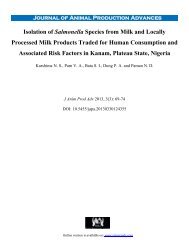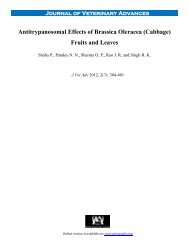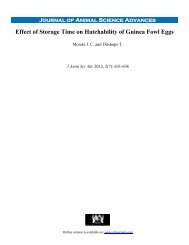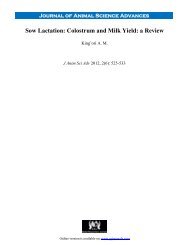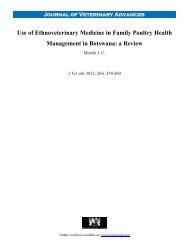PDF Download
PDF Download
PDF Download
You also want an ePaper? Increase the reach of your titles
YUMPU automatically turns print PDFs into web optimized ePapers that Google loves.
Journal of Veterinary Advances<br />
Evaluation of Immune Status of the Chicken using<br />
Morphometry and Histology of the Bursa of Fabricius<br />
Sellaoui S., Alloui N., Mehenaoui S. and Djaaba S.<br />
J Vet Adv 2012, 2(8): 440-443<br />
Online version is available on: www.grjournals.com
EVALUATION OF IMMUNE STATUS OF THE CHICKEN USING MORPHOMETRY …<br />
Introduction<br />
The bursa of Fabricius is an immunological<br />
organ that plays a primordial role in the poultry<br />
immunity (Toivanen et al 1987). It is according to<br />
its physiological state that will especially depend on<br />
the immune status of poultries at the beginning of<br />
broiler chickens weight development. The different<br />
aggressions of the environment (stress, bad hygiene,<br />
vaccination, pathologies…) undergone by birds,<br />
influential on the anatomical and physiological<br />
development of the bursa of Fabricius. It can,<br />
therefore, lead to an immunodepression at certain<br />
birds. The use of vaccines called virulent "warm"<br />
can sometimes compromise immunity at poultries<br />
while causing some lesions of this organ (OIE 2001,<br />
van Denberger et al 2000). The consecutive<br />
immunodepression to lesions of this vital organ<br />
provokes very often negative vaccinal reactions and<br />
some complications in poultry flocks: bad<br />
absorption, secondary infection, weak gain of<br />
weight and finally diverse diseases. In this survey,<br />
we valued morphometrical and histological<br />
evolution of the broiler cloacal bursa in the natural<br />
conditions.<br />
Materials and Methods<br />
The investigation is done on nine flock poultry<br />
of 3000 broilers each, elevated in open broiler<br />
houses and vaccinated against the infectious bursal<br />
disease (IBD) with a vaccine "Intermediate plus".<br />
Morphometrical survey of the bursa of Fabricius<br />
has been done thanks to the method of Kuney<br />
(1982). Broilers are weighed then sacrificed during<br />
raising. The autopsy is achieved on broiler chickens<br />
presenting no clinical sign of disease. The bursa of<br />
Fabricius are taken, examined, weighed and<br />
measured with the help of a "bursameter"(Fig.1).<br />
The calculation of bursal index (BI) is obtained by<br />
the following formula: weight of Fabricius bursa /<br />
body weight x 100.<br />
Histological cuts of Fabricius bursa are<br />
prepared from broiler chickens of every flock<br />
according to the conventional method (Campell,<br />
1995). Histopathological observation is realized<br />
thanks to an optic microscope AXIOSCOPZO - ICS<br />
- Zeiss. For the assessment of broiler chickens<br />
immune status, we used the method developed by<br />
441 J. Vet. Adv., 2012, 2(8):440-443<br />
Solvay (1992) based on the degree of severity of<br />
lymphocyte depletion in the medullary follicular<br />
zone of this organ.<br />
Results and discussion<br />
The bursal index (BI) calculated during all the<br />
period of raising ( 49 day) for the 9 flocks of broiler<br />
chickens demonstrates that more than the half<br />
belong to the bad class (57.63%) and only a quarter<br />
belongs to the one excellent (27.75%), what<br />
confirms the heterogeneity of poultry flocks (Table<br />
1).<br />
The evolution of the bursal weight with regard<br />
to the body weight gives a correlation coefficient r 2<br />
= 0.54 (Fig. 2). It is a positive and significant<br />
correlation (p≤ 0.001), what explains that the<br />
weight of the bursal increased effectively according<br />
to the body weight, but without reaching some<br />
compliant values This variation of the bursal<br />
morphology demonstrates the immunodepression<br />
state at certain broilers chickens (Table2). Lesionel<br />
score survey demonstrated that more than the half<br />
(53%) of the examined organs present lesions of<br />
different degrees (photo 1, 2, 3). The distribution of<br />
the observed lesions is very variable within the<br />
different flocks and even inside of one same flock.<br />
They are especially characterized by atrophy,<br />
lymphocyte depletion. In the more serious cases,<br />
one notes a follicular lymphoid necrosis, an<br />
interfollicular interstitial fibrosis and a degeneration<br />
of the coating epithelium (not mentioned). The<br />
observed lesions of Fabricius bursa are caused by a<br />
wild virus of IBD having infected broiler chickens<br />
since their arrival in the badly decontaminated<br />
buildings or by the vaccinal strain called<br />
"Intermediary plus". Researches demonstrated, that<br />
in spite of an elevated rate of maternal antibodies at<br />
broiler chicks, it can have precocious and lasting<br />
colonization of the bursa of Fabricius there by a<br />
wild strains (Allamigeon and Count, 2003). It exists<br />
an optimum moment of difficult vaccination to<br />
determine, it is necessary sufficiently of maternal<br />
antibodies to master a possible wild strain but not<br />
too much to not neutralize the vaccinal virus<br />
(Goutebroze and al. 2003; Lemière 2003).<br />
Boudaoud (2004,2008) demonstrated the<br />
immunodepression and pathological state caused of
ursal weigt (g)<br />
SELLAOUI ET AL.<br />
“intermediate plus” vaccine strains against IBD<br />
with regard to those so-called “intermediate.”<br />
Table.1: Bursal index (BI) in boiler flocks (%)<br />
Class<br />
Flock<br />
BI > de 0.20%<br />
(excellent)<br />
0.18%< BI< 0.20%<br />
(average)<br />
0.15%< BI< 0.18%<br />
(mediocre)<br />
BI< de 0.15%<br />
(bad)<br />
1<br />
2<br />
3<br />
4<br />
5<br />
6<br />
7<br />
8<br />
9<br />
28.12<br />
19<br />
40.9<br />
22.22<br />
27.77<br />
31.25<br />
18.75<br />
6.22<br />
31.57<br />
3.12<br />
4.76<br />
4 .54<br />
11.11<br />
11.11<br />
0<br />
6.25<br />
0<br />
10.5<br />
3.12<br />
4.76<br />
4 .54<br />
22.22<br />
11.11<br />
0<br />
6.25<br />
6.45<br />
10.5<br />
62<br />
71.42<br />
50<br />
44.44<br />
50<br />
68.75<br />
68.75<br />
61.29<br />
42.1<br />
Mean 27.75 5.71 7.96 57.63<br />
Table 2: Lesional score of Fabricius bursae in poultry broilers (n = 62)<br />
*Lesional score 0 1 2 3 4<br />
% of Fabricius bursae affected 47 10 5 32 6<br />
* 0 = normal, 1 = 61%.<br />
Fig. 1: Bursameter (Solvay animal health, 1992).<br />
3.5<br />
3<br />
y = 0.0005x + 0.2951<br />
R² = 0.5432<br />
2.5<br />
2<br />
1.5<br />
1<br />
0.5<br />
0<br />
0 250 500 750 1000 1250 1500 1750 2000 2250 2500 2750 3000 3250 3500<br />
body weigth (g)<br />
Fig. 2: Correlation between body weight and bursal weight in the broiler chickens.<br />
442 J. Vet. Adv., 2012, 2(8):440-443
EVALUATION OF IMMUNE STATUS OF THE CHICKEN USING MORPHOMETRY …<br />
calculating of percentage and bursal index are easy<br />
ways and not expensive to evaluate the immune<br />
status in the broiler, which allows to identify the<br />
problem in time at the end to remedy and<br />
correct failures.<br />
References<br />
Photo1.<br />
Left: Normal bursa.<br />
Right: Atrophied and hemorrhagic bursa.<br />
Photo 2: Lympho-epithelial follicles with. Clear<br />
medulla and dark cortical, a clear basal membrane as a<br />
chapelet (X40).<br />
Photo 3: Intrafollicular cystic cavities and interstitial<br />
edema (X40).<br />
Conclusion<br />
Alloui N, Ayachi A, Alloui Lombarkia O, Zeghina D (2001).<br />
Evaluation de l’effet du statut hygiénique des poulaillers<br />
sur les performances zootechniques. Vème journée de la<br />
recherche avicole. Tours: 485-488.<br />
Awad MH (2002). Immunity and immunosuppression in birds.<br />
Poultry Middle East and North Africa., 163: 21-22<br />
Bennet C (2002). How to score bursa size in broiler chicken<br />
flocks. UN Crescent Winni peg.<br />
Boudouad A (2004). Evaluation de l’innocuité de vaccins<br />
atténués de la maladie de Gumboro chez le poussin<br />
conventionnel. Mémoire magistère, Université de Batna,<br />
Algérie<br />
Boudaoud A, Alloui N (2008). Evaluation of the safety of live<br />
attenued vaccine virus against infectious bursal disease<br />
in conventional broiler chicks. Rev. sci. tech. Off. Int.<br />
Epiz., 27(3), 793-802<br />
Hupaya JR (1995). Evaluacion de la bursa de Fabricio en<br />
pollos broilers. Estudio anatomo-histologico.Tesis.Peru.<br />
Kuney D (2000). Bursameter a tool for measuring the size of<br />
the bursa of Fabricius. Solvay Animal Health.<br />
Lemiere S (2003). Présentation d’un modèle permettant de<br />
déterminer la date de vaccination de la maladie de<br />
Gumboro du poulet de chair. Vème journée de la<br />
recherche avicole Tours, 335-338<br />
Pastoret P, Gzovaerts A Basin H (1990). Immunologie<br />
animale. Flammarion 740p<br />
Sandoval GL, Terraes JC, Revidatti FA (2002) Consecuencias<br />
de practicas de manejo estresantes en el desalojo del<br />
tejido de la bolsa en pollos parrilleras. Thesis. Facultad<br />
de Ciencias Veterinarias-Universidad de Argentina.<br />
Toivanen P, Naukkarinene H, Vannino O (1987). What is the<br />
function of the bursa of Fabricius. Avian immunology<br />
(Basis and practice). Vol 1: 79-92.<br />
Youbicier Simo BJ, Boudard F, Mekaouche M (1993).<br />
Effects of embryonic bursectomy and in ovo<br />
administration of highly diluted bursin on<br />
adrenocorticotropic and immune responses of chickens.<br />
J. immunopathol-pharmacol. 9, 169- 180.<br />
The morphometric study demonstrates that the<br />
immune status of broilers is below standard.<br />
Determining bursa: body weight ratio,<br />
morphometrical and histopathological studies,<br />
443 J. Vet. Adv., 2012, 2(8):440-443





